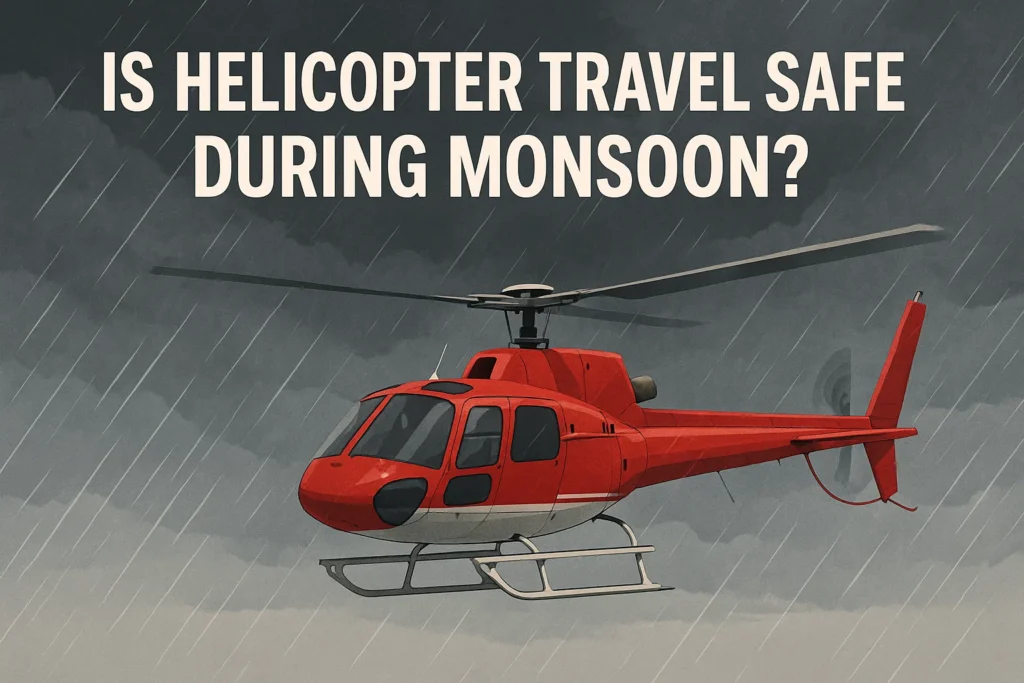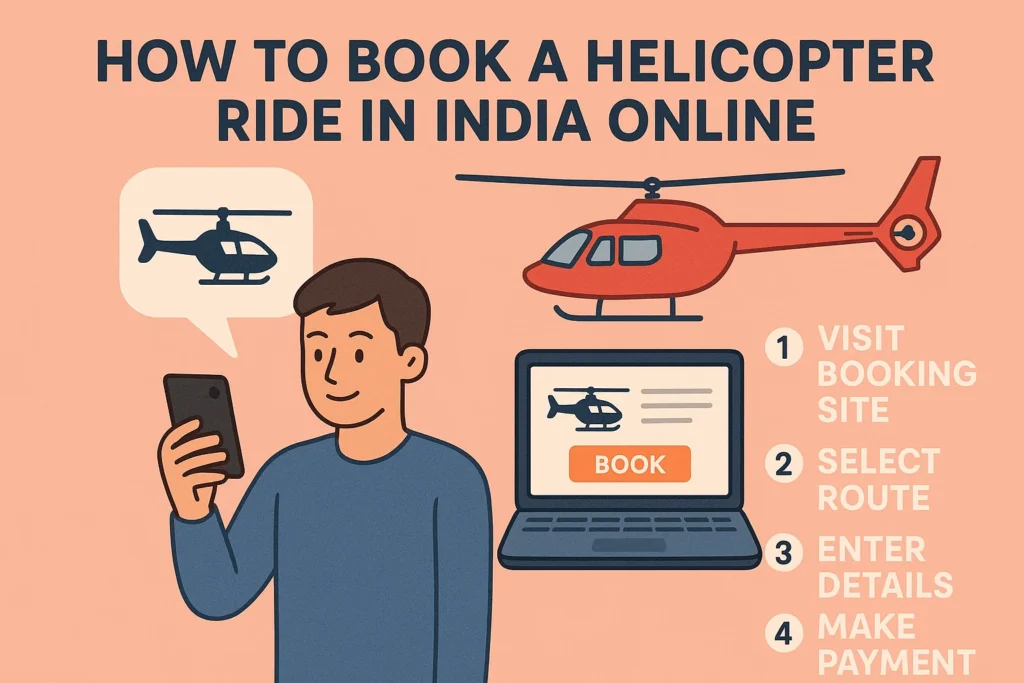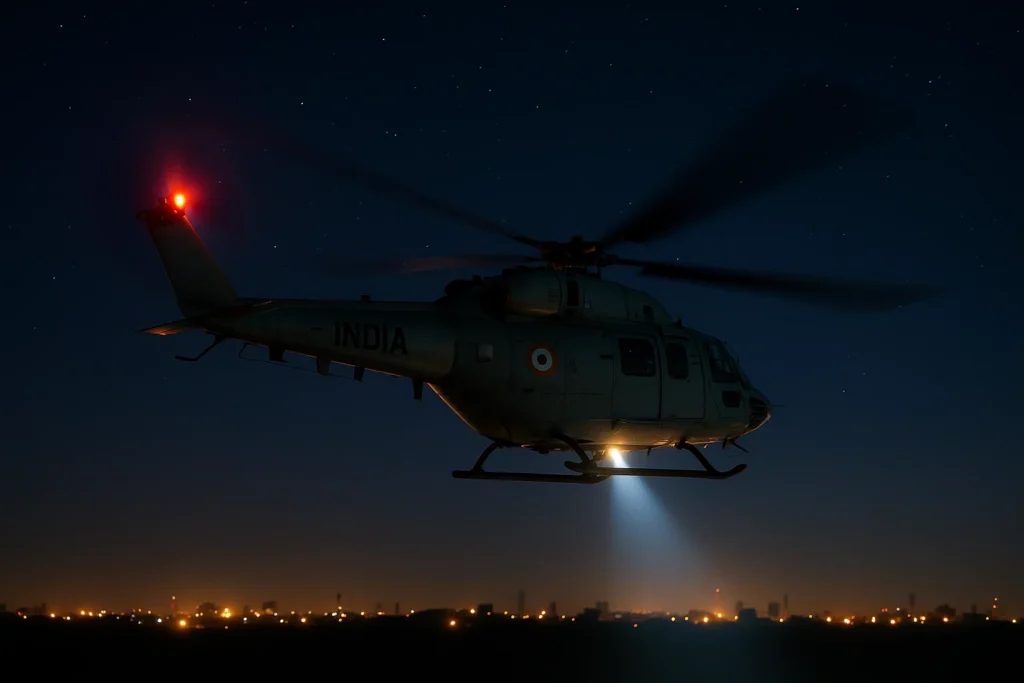✨ Introduction: Is Helicopter Travel Safe During Monsoon?
Monsoon season in India brings heavy rains, winds, and stormy weather, making many people wonder if helicopter travel is safe during this time. While monsoons can present challenges for air travel, helicopters are designed with safety features that make them capable of handling adverse weather conditions. However, safety remains the top priority for helicopter operators, and there are specific precautions and regulations that are followed to ensure safe operations during monsoon months.
In this blog, we’ll explore whether helicopter travel is safe during monsoon and how helicopter operators ensure safety in adverse weather conditions.
🌍 Understanding the Risks of Helicopter Travel During Monsoon
1. Heavy Rainfall and Reduced Visibility
Monsoon rains often lead to reduced visibility, which can make flying more challenging. Pilots rely on visual cues and instrumentation to navigate, and heavy rain can impair visibility and increase the risk of disorientation.
-
Risk: Heavy rain and fog can reduce visibility, making it more difficult for pilots to see obstacles, such as buildings, power lines, and other aircraft.
-
Safety Measures: Modern helicopters are equipped with advanced weather radar, flight instruments, and infrared cameras that allow pilots to safely navigate through adverse weather conditions.
2. Strong Winds and Turbulence
Monsoon weather is often accompanied by strong winds and turbulence, which can make flying more challenging. Wind gusts can affect the stability and maneuverability of helicopters, particularly during takeoff and landing.
-
Risk: Strong winds and turbulence can make the helicopter ride uncomfortable or even cause sudden altitude shifts if not properly managed.
-
Safety Measures: Helicopter pilots are trained to handle wind turbulence and have access to real-time weather updates to avoid dangerous flight paths. Helicopters are also designed to withstand turbulent conditions.
3. Thunderstorms and Lightning
Thunderstorms are common during the monsoon season and can bring dangerous weather phenomena like lightning, hail, and intense gusts. Flying in or near thunderstorms poses a significant safety risk due to the unpredictable weather and extreme turbulence.
-
Risk: Lightning strikes and severe turbulence from thunderstorms can be hazardous to helicopters. Thunderstorms can also lead to rapid weather changes, complicating flight operations.
-
Safety Measures: Helicopter operators closely monitor weather forecasts to avoid flying through storms. Pilots are trained to divert flights or delay operations if severe weather is predicted.
🌍 Helicopter Travel Safety Protocols During Monsoon
1. Pre-Flight Weather Monitoring
Before every helicopter flight, especially during monsoon season, operators conduct thorough weather assessments to ensure it’s safe to fly. The weather data includes wind speeds, rain forecasts, visibility levels, and storm predictions.
-
Real-Time Weather Updates: Helicopter operators have access to real-time weather tracking systems to ensure they are aware of changing weather conditions along the flight route. This allows them to adjust flight paths to avoid bad weather.
2. Flight Cancellations and Delays
In certain cases, if the weather is deemed unsafe for flying, helicopter flights may be delayed or cancelled. This is a standard practice to prioritize passenger safety over convenience.
-
Safety First: If heavy rains, strong winds, or lightning are predicted along the flight path, the operator may postpone or reschedule the flight to ensure your safety.
-
Passenger Notifications: In case of a flight delay or cancellation, passengers will be promptly notified and offered alternative arrangements or refunds as per the operator’s policies.
3. Helicopter Design Features for Monsoon Weather
Modern helicopters are equipped with several advanced design features that help improve stability and safety during monsoon weather:
-
Turbine Engines: Most modern helicopters use turbine engines, which provide better power output and stability during adverse weather conditions.
-
Advanced Instrumentation: Helicopters come with advanced navigation instruments, including weather radar, altimeter, and infrared cameras, to allow pilots to navigate safely through low-visibility conditions.
-
Lightning Protection: Helicopters are equipped with lightning protection systems to shield the aircraft in case of lightning strikes.
4. Experienced Pilots and Training
Helicopter pilots are extensively trained to fly in varied weather conditions, including monsoon weather. They are skilled in handling turbulence, heavy rain, and reduced visibility, ensuring safe operations during challenging conditions.
-
Ongoing Training: Pilots undergo regular training and simulations to handle emergency situations and adverse weather while in flight.
-
Communication with ATC: Pilots maintain constant communication with Air Traffic Control (ATC) to ensure they are aware of any changing weather conditions during the flight.
🌍 Safety Tips for Helicopter Travel During Monsoon
1. Follow Safety Briefings
Before your helicopter flight, always listen carefully to the safety briefing provided by the pilot or ground crew. This briefing will cover the safety protocols specific to the flight, especially in adverse weather conditions.
2. Check Weather Updates Before Booking
Before booking a helicopter ride during the monsoon, check the weather forecast and make sure the weather conditions are favorable for flying. If there are heavy rains or thunderstorms expected, consider rescheduling your flight for a later time.
3. Be Prepared for Delays
Understand that monsoon weather can lead to delays or cancellations. Plan accordingly by allowing extra time and having backup travel arrangements in place.
4. Stay Calm During the Flight
If you experience turbulence or slight discomfort during the flight, remember that helicopters are designed to withstand turbulent conditions. The pilot is trained to handle these situations, and the flight will remain safe throughout the journey.
🌍 Conclusion: Is Helicopter Travel Safe During Monsoon in India?
While helicopter travel during the monsoon season can present certain challenges, modern helicopters are designed to handle rain, wind, and turbulence, ensuring passenger safety. Helicopter operators in India adhere to strict safety guidelines and work with experienced pilots and advanced technologies to navigate through adverse weather.
At DreamSafar, we prioritize safety and comfort for all passengers, especially during the monsoon season. We closely monitor weather conditions and take all necessary precautions to ensure your helicopter journey is as safe and enjoyable as possible.
🔗 Useful Links:
Resources:
❓ FAQ Section:
Q1: Is it safe to fly in a helicopter during monsoon in India?
A1: Yes, helicopters are designed to handle adverse weather conditions like rain and wind. Pilots are trained to navigate through turbulent weather, and safety protocols are strictly followed during monsoon flights.
Q2: How do helicopter operators ensure safety during monsoon weather?
A2: Helicopter operators monitor real-time weather updates, and flight cancellations or delays may occur if conditions are unsafe. Helicopters are equipped with advanced navigation systems to assist pilots in low-visibility conditions.
Q3: Can I book a helicopter ride during the monsoon season?
A3: Yes, you can book a helicopter ride during the monsoon season. However, it’s important to check the weather forecast and be prepared for potential delays or cancellations.


